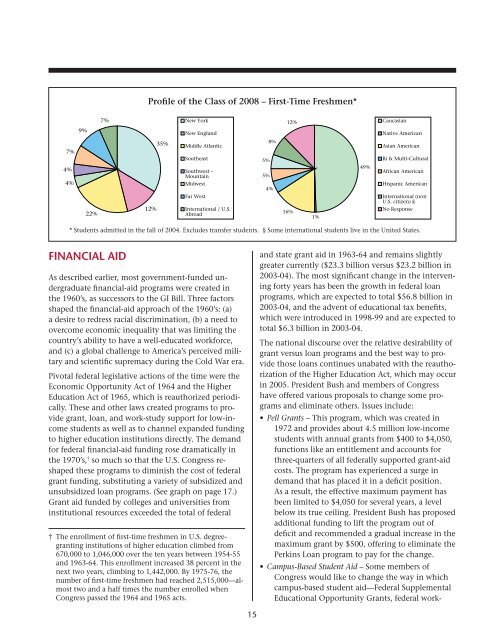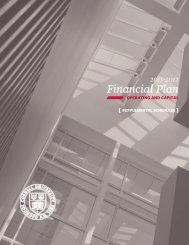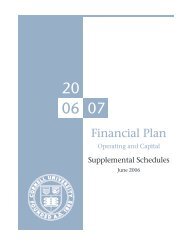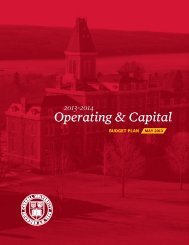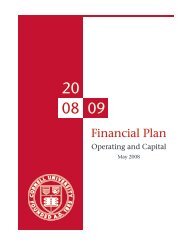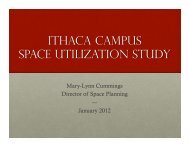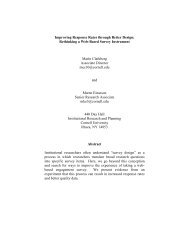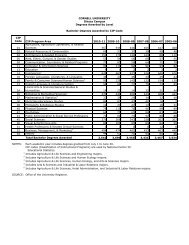Undergraduate Student Access - Cornell University Division of ...
Undergraduate Student Access - Cornell University Division of ...
Undergraduate Student Access - Cornell University Division of ...
You also want an ePaper? Increase the reach of your titles
YUMPU automatically turns print PDFs into web optimized ePapers that Google loves.
Pr<strong>of</strong>ile <strong>of</strong> the Class <strong>of</strong> 2008 – First-Time Freshmen*7% New York12% Caucasian9%New EnglandNative American7%4%4%35%Middle AtlanticSoutheastSouthwest –MountainMidwest8%5%5%4%49%Asian AmericanBi & Multi-CulturalAfrican AmericanHispanic American22%12%Far WestInternational / U.S.Abroad16%1%International (nonU.S. citizen) §No Response* <strong>Student</strong>s admitted in the fall <strong>of</strong> 2004. Excludes transfer students. § Some international students live in the United States.FINANCIAL AIDAs described earlier, most government-funded undergraduatefinancial-aid programs were created inthe 1960’s, as successors to the GI Bill. Three factorsshaped the financial-aid approach <strong>of</strong> the 1960’s: (a)a desire to redress racial discrimination, (b) a need toovercome economic inequality that was limiting thecountry’s ability to have a well-educated workforce,and (c) a global challenge to America’s perceived militaryand scientific supremacy during the Cold War era.Pivotal federal legislative actions <strong>of</strong> the time were theEconomic Opportunity Act <strong>of</strong> 1964 and the HigherEducation Act <strong>of</strong> 1965, which is reauthorized periodically.These and other laws created programs to providegrant, loan, and work-study support for low-incomestudents as well as to channel expanded fundingto higher education institutions directly. The demandfor federal financial-aid funding rose dramatically inthe 1970’s, † so much so that the U.S. Congress reshapedthese programs to diminish the cost <strong>of</strong> federalgrant funding, substituting a variety <strong>of</strong> subsidized andunsubsidized loan programs. (See graph on page 17.)Grant aid funded by colleges and universities frominstitutional resources exceeded the total <strong>of</strong> federal† The enrollment <strong>of</strong> first-time freshmen in U.S. degreegrantinginstitutions <strong>of</strong> higher education climbed from670,000 to 1,046,000 over the ten years between 1954-55and 1963-64. This enrollment increased 38 percent in thenext two years, climbing to 1,442,000. By 1975-76, thenumber <strong>of</strong> first-time freshmen had reached 2,515,000—almosttwo and a half times the number enrolled whenCongress passed the 1964 and 1965 acts.and state grant aid in 1963-64 and remains slightlygreater currently ($23.3 billion versus $23.2 billion in2003-04). The most significant change in the interveningforty years has been the growth in federal loanprograms, which are expected to total $56.8 billion in2003-04, and the advent <strong>of</strong> educational tax benefits,which were introduced in 1998-99 and are expected tototal $6.3 billion in 2003-04.The national discourse over the relative desirability <strong>of</strong>grant versus loan programs and the best way to providethose loans continues unabated with the reauthorization<strong>of</strong> the Higher Education Act, which may occurin 2005. President Bush and members <strong>of</strong> Congresshave <strong>of</strong>fered various proposals to change some programsand eliminate others. Issues include:• Pell Grants – This program, which was created in1972 and provides about 4.5 million low-incomestudents with annual grants from $400 to $4,050,functions like an entitlement and accounts forthree-quarters <strong>of</strong> all federally supported grant-aidcosts. The program has experienced a surge indemand that has placed it in a deficit position.As a result, the effective maximum payment hasbeen limited to $4,050 for several years, a levelbelow its true ceiling. President Bush has proposedadditional funding to lift the program out <strong>of</strong>deficit and recommended a gradual increase in themaximum grant by $500, <strong>of</strong>fering to eliminate thePerkins Loan program to pay for the change.• Campus-Based <strong>Student</strong> Aid – Some members <strong>of</strong>Congress would like to change the way in whichcampus-based student aid—Federal SupplementalEducational Opportunity Grants, federal work-15


